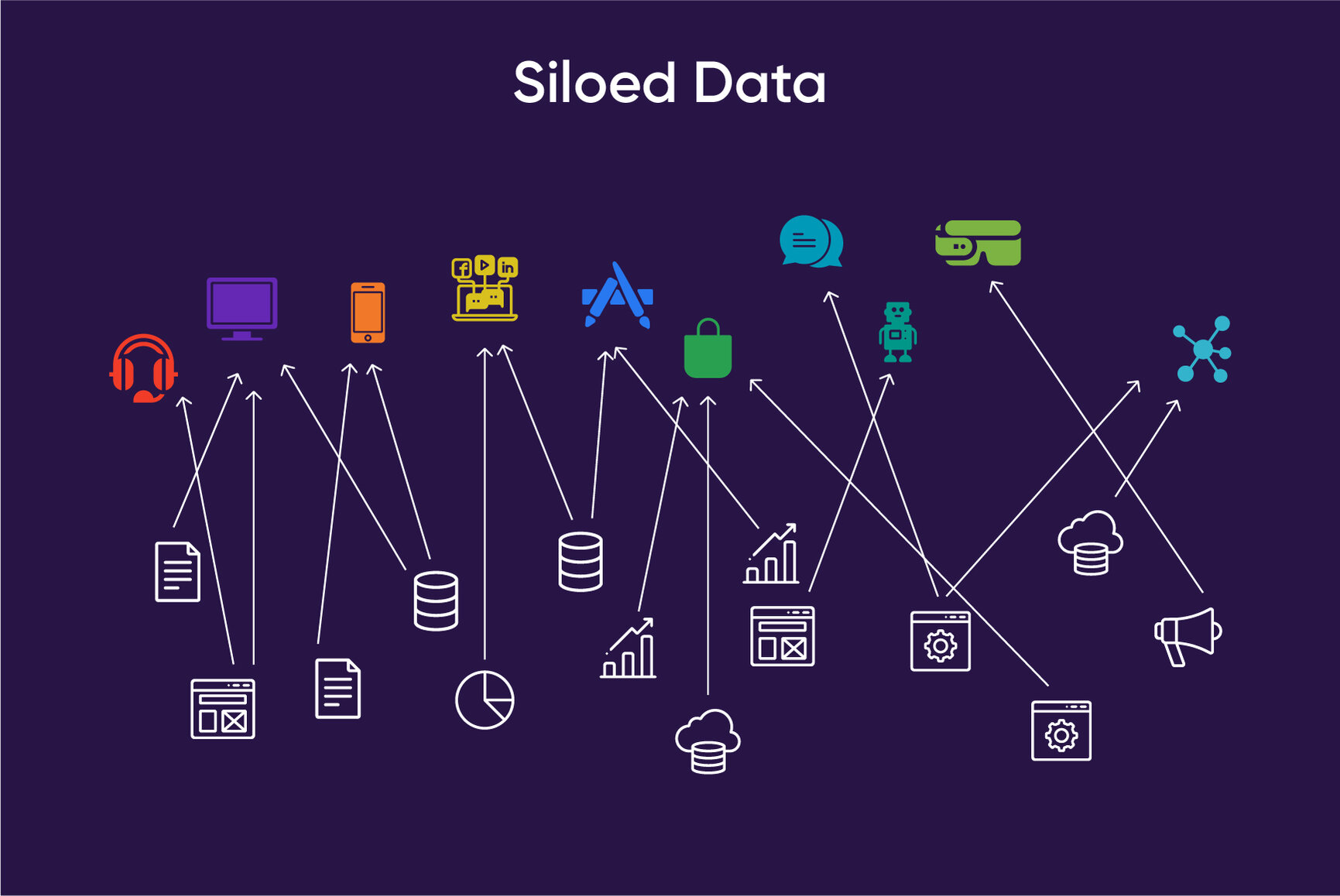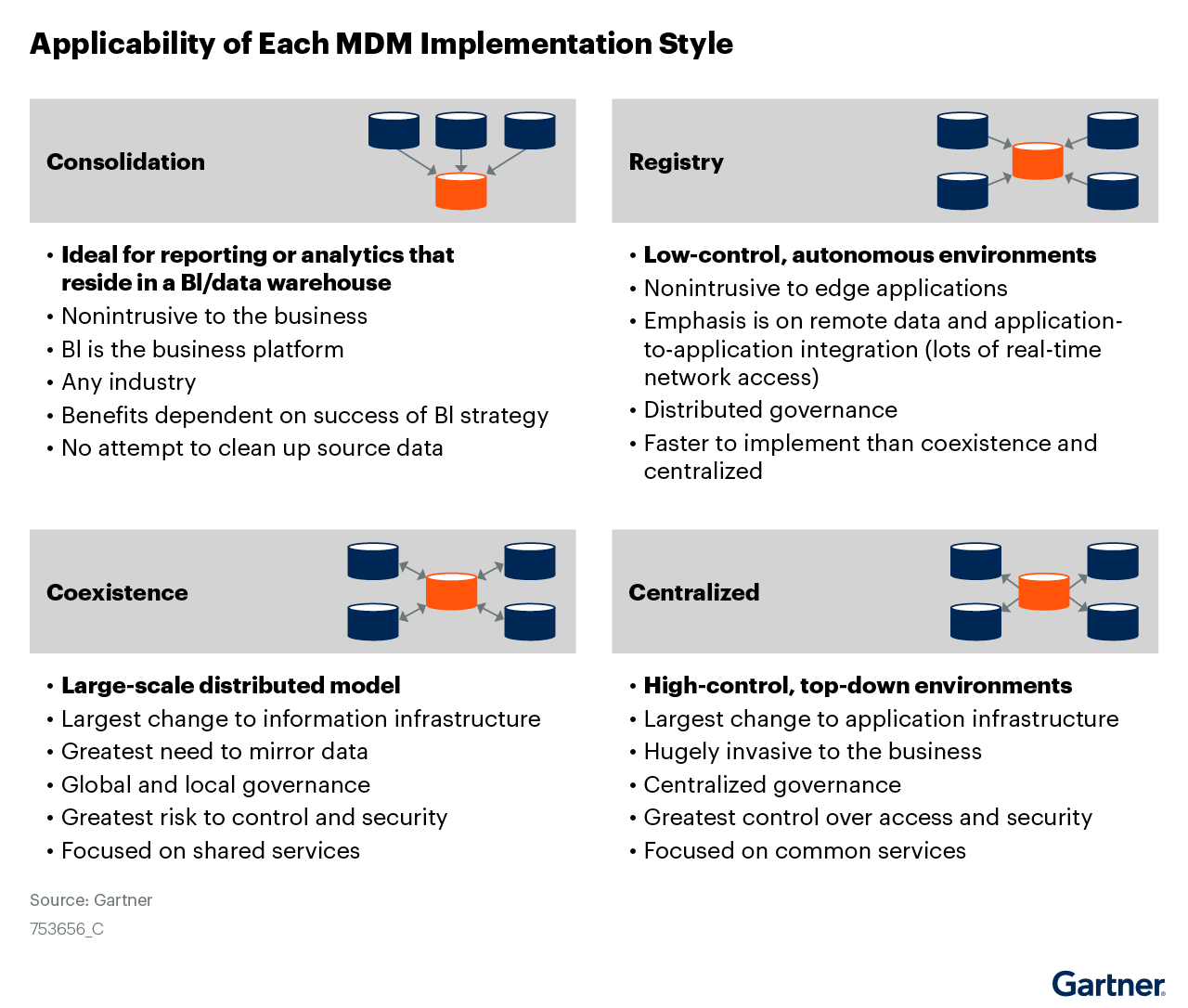A Guide to Master Data Management Implementation Styles
Master data is integral for the smooth running of core business processes and applications. High quality, reliable, up-to-date, and easily accessible master data enriches algorithmic processes for the uninterrupted functioning of operations and better business outcomes. If it is not managed and governed appropriately, organizations can suffer from lower operational efficiency, unsatisfactory customer experience, and higher IT costs.
What You’ll Learn From This Insight:
I. Master Data Without Proper Management
II. Understanding Master Data Management
III. Assessing Your Organization's MDM Implementation Needs
IV. Problems with MDM Implementation
V. Why are MDM Implementation Styles Required?
VI. Types of MDM Implementation Styles
VII. How to Choose the Right MDM Implementation Style?
1. Master Data Without Proper Management
The volume and variety of enterprise-wide master data is growing at an unprecedented rate. The biggest challenge for enterprises is to create a uniform set of identifiers and a standard set of attributes (extended one, as well) for its core entities like customers, products, suppliers, employees, hierarchies, and more, especially when their different applications and systems have been developed and deployed in silos. This creates problems of data silos, multiple versions of data, data inaccuracy or errors, and outdated data. So, it becomes tough to know which elements of your data you can trust, which you cannot.
Here, the management of master data has little to do with just technology more about strategy and implementation. The essential factor is organizational commitment and skills to ensure that their master data always remains well-managed and up-to-date for higher business growth.

2. Understanding Master Data Management
Gartner defines Master Data Management (MDM) as a technology-enabled discipline in which business and IT work together to ensure the uniformity, accuracy, stewardship, semantic consistency and accountability of the enterprise’s official shared master data assets. Master data is the consistent and uniform set of identifiers and extended attributes that describes the core entities of the enterprise, including customers, prospects, citizens, suppliers, sites, hierarchies, and chart of accounts.
Multidomain MDM
Multidomain MDM is concerned with managing master data across multiple domains. While some MDM functions and disciplines can and should be leveraged across multiple domains, some of those functions and disciplines within each domain are still specific enough or have distinct business requirements, so they need very specific management and implementation.
As MDM is applied across more domains, these functions and their associated tools and processes become more reusable or adaptable. Certain functions, such as data quality, are extremely broad. Multidomain MDM programs need effective engagement and collaboration between the business and IT departments.
3. Assessing Your Organization's MDM Implementation Needs
With master data management, a robust foundation for data modeling as per organizational perspective, and improved data governance for data reuse and sharing can be laid out that can explicitly accelerate your business strategy.
Every industry implements an MDM platform as per their unique requirement. Some general-purpose MDM tools might not serve the specific purpose, so enterprises need a specialized one. There are many use cases of master data management and any use case majorly depends upon the criticality of business needs. Amongst several MDM use cases, the two most common are operational MDM and analytical MDM.
Operational MDM
Operational MDM is about establishing MDM at its source. So, master data is managed and governed at the point where the enterprise recognizes it. All the efforts are made to make sure that data consistency remains throughout the enterprise to ensure the integrity of the business process. In this segment, two discrete areas have emerged that focus on specific data domains. One is MDM for product data, or also called product data information management (PIM), and the other is MDM for customer data. Currently, these two segments have quite evolved. In fact, they are now being addressed by a mix of single-domain-centric offerings and multidomain MDM offerings. Operational MDM's focus is on all-consuming systems, applications, and purposes.
Analytical MDM
Analytical MDM is more about establishing MDM skills, tools, and technologies, like data cleaning and data quality. It refers to data accessibility that is utilized for business intelligence, reporting, and analytics. Unlike operational MDM, it does not mandate to fix the data at its source despite having all data at one place; in fact, it is used to measure the business. Analytical MDM's focus is on all downstream BI requirements. It is deployed downstream of the transaction/operational systems and is part of the BI implementations.
4. Problems with MDM Implementation
Master data is a uniform set of identifiers and attributes describing core data objects (e.g., “customer” or “product”). A master data object maintains its integrity even when different users need different views of it. Organizations can use MDM to prevent or help resolve data conflicts, sometimes by creating a single hub where all master data is managed. If master data management is not used effectively, then a lot of remedial actions will be necessary — and they take time and money better spent on other things. The consequences can be:
• Increased operational costs that impair the efficiency of the organization
• Delays in bringing new products/projects to market (with an associated delay in accruing revenue and profit)
• Reluctance to try avenues for new business, due to lack of confidence in the data (opportunity cost)
• Inefficiencies in correcting mistakes or failure to detect fraud
5. Why are MDM Implementation Styles Required?
Master data management implementation styles are crucial for successful MDM solution deployment. They play a key role in architecting the MDM system, whether you are building component-based systems or using purchased as a platform. They are needed when an organization wants to improve:
- Data quality: Right MDM implementation style improves the quality of your master data and enhances the consistency and managed use of this information in what is often a complex and somewhat tangled environment.
- Data accessibility: Help support the operational environment/decision-making environment, push clean data back into existing systems, build service-oriented architecture (SOA) fabric, enable demographic distribution, and other unique MDM requirements.
- Data governance: Ensure effective information governance by providing a set of policies, procedures, and controls that improve the accuracy, completeness, consistency, and security of an organization's data.
- Business agility: Enhance business agility by providing a flexible and scalable solution that can adapt to changing business needs. It induces effectiveness and agility of existing master data across departments and provides deeper business insights for faster decision-making.
- Cost-effectiveness: Help reduce costs by providing a low-cost solution for developing a golden record. Overall, it minimizes operational and system costs.
The choice of MDM implementation style depends on various factors such as organizational structure, business needs, and the number of data sources. Different implementation styles have come to the fore to address different business needs.
6. Types of MDM Implementation Styles
Master data can be stored in several ways and implemented in a range of styles. There are four master data management (MDM) implementation styles, and their different characteristics suit different organizational needs.
These include consolidation, registry, centralized and, ultimately, coexistence. These styles support differing degrees to which master data is stored and governed centrally, or in a distributed fashion. Some are more invasive or disruptive than others in their impact on IT and business environments.
(1) Consolidation Style
Used primarily to support business intelligence (BI) or data warehousing initiatives. This is generally referred to as a downstream MDM style, in that MDM is applied downstream of the operational systems where master data is originally created.
(2) Registry Style
Used primarily as an index to master data that is authored in a distributed fashion and remains fragmented across distributed systems.
(3) Coexistence Style
Used primarily where master data authoring is distributed, but a "golden copy" is maintained centrally in a hub. The central system publishes the golden copy master data to subscribing systems.
(4) Centralized Style
Used where master data is authored, stored, and accessed from one or more MDM hubs, either in a workflow or a transaction use case.
7. How To Choose the Right MDM Implementation Style?
Master data management implementation is a tricky one. Sometimes, it becomes difficult for organizations to decide which MDM approach to adopt. Some organizations need to use MDM for product information management to support their global product data synchronization or supply chain management.
Other organizations may need to use MDM for customer data applications to support customer-centric objectives. So, it all depends upon different business requirements that businesses have to get a single view of their master data.

Here are additional steps to help you choose the right MDM implementation style for your organization:
- Assess your business needs: Determine the primary goal of implementing MDM in your organization. This could be improving data quality, maintaining legacy systems, or providing data accessibility.
- Evaluate the level of control: Consider whether you want a centralized (transactional) style, where the MDM authors the master data and disseminates it to other systems or applications, or a more decentralized approach like the coexistence style, which creates a consolidated data hub that feeds updated records back to sources.
- Determine the level of intrusiveness: Assess the extent to which your organization is willing to change its application infrastructure. The registry style is the least intrusive, while the centralized style requires the most change.
- Consider the number of data sources: The number of data sources in your organization will influence the choice of MDM implementation style. For organizations with extensive data sources, a centralized or consolidation style might be more suitable.
- Evaluate the presence of data stewards: The implementation style you choose should consider the human element in the MDM process. The consolidation style, for example, introduces data stewards who can make appropriate corrections to questionable data.
- Align with your MDM usage scenario: Depending on whether your organization wants to employ analytical MDM or operational MDM, the choice of implementation style will differ.
- Budget and resources: The cost and resources required for each implementation style should be considered. The registry style is the most cost-effective, while the centralized style requires more resources and budget.
By carefully evaluating these factors, you can choose the right MDM implementation style that best suits your organization's needs and goals.
However, MDM is a long-term commitment; organizations must use a best-of-breed solution that not just supports their main data domains but any number of data domains. So, organizations should choose a single-domain master data management solution where it makes sense, and if a single domain solution cannot meet requirements, they should consider multidomain MDM.
8. Strategy for Successful MDM Implementation
MDM implementation demands a long-term vision, effective technical infrastructure for collaboration, and organizational preparedness. It would be best if you did the necessary groundwork to clearly define steps and ensure enterprise acceptance with cost management goals.
Here are few tips you should consider to overcoming the probable hurdles:
- Define and clarify your business requirements and build an MDM business case with a vision.
- Focus on real business-oriented problems or scenarios.
- Set budget for the master data management implementation program.
- Design and implement an MDM solution in small steps.
- Align your MDM implementation architecture with your long-term information infrastructure strategy.
- Scale MDM within the organization across departments and observe the benefits.
- Create a long-term MDM roadmap and maximize its benefits.
9. Guided Product Tour of Pimcore MDM
Pimcore MDM Platform
Pimcore MDM is the leading open source MDM software available in the market. This guided product tour helps you get the most out of Pimcore MDM by providing a personalized overview of the software's features and functionality. This tour can save you time and effort, plus you can experience the software to see how it can benefit your business.
- Background of Master Data Management
- Technology Trends Affecting MDM
- Consumer Behaviors Affecting MDM
- Best Practices for Master Data Management
- MDM Backbone: People, Process, and Technology